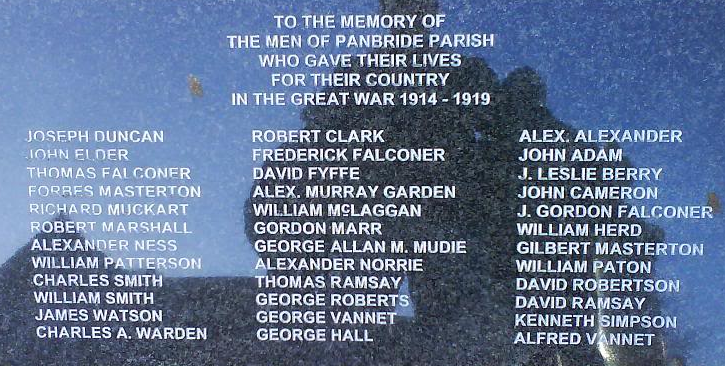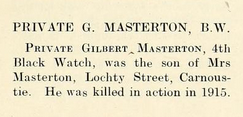Private Gilbert Newnes Masterton
2583, 4th Battalion, Black Watch (Royal Highlanders)
killed in action 9th May 1915
aged 22
Le Touret Memorial
Panbride War Memorial
Son of John Masterton and Ellen Scollay
Lochee, Dundee, Scotland
aged 22
Le Touret Memorial
Panbride War Memorial
Son of John Masterton and Ellen Scollay
Lochee, Dundee, Scotland
Genealogy
Gilbert Newnes Masterton was born at 114 Mid Street, Lochee, Dundee, Scotland on 11 December 1892, the thirteenth child of John Masterton, Commercial Traveller, Grocer and photographer, and Ellen Scollay. Ellen was 44 years old when Gilbert was born. In 1908, Gilbert's father John died in the Commercial Hotel, Portsoy, Banff. By 1915, Ellen was living in Lochty Street, Carnoustie, Angus, Scotland. Gilbert's older brother Forbes was also killed in the war in 1917. Further details of Gilbert's parents and twelve siblings and the extended family of Mastertons originating from Largo can be found at the following link.
His War
Private Gilbert Newnes Masterton enlisted with the Black Watch (Royal Highlanders). He was in the 4th Battalion, a Territorial Battalion that left Tay Bridge Station in Dundee on 23rd February 1915 for Southampton. The battalion embarked on SS Rossetti and landed at Le Havre on 26th February 1915 joining the Bareilly Brigade in the 7th Meerut Division of the Indian Army Corps. Each brigade of the Indian Corps consisted of one British and three Indian battalions. By 5th March, the first companies of the 4th Black Watch were in the front line trenches. From 10th to 14th March, it took part in the Battle of Neuve Chapelle and after a brief period of rest, continued to hold the line around Neuve Chapelle until the beginning of May.
On 10th April, when the battalion was in billets, it was inspected by Sir John French and Sir Douglas Haig. Sir John addressed them:
"Fourth Battalion, The Black Watch, I must address you in a somewhat different manner from that which I have spoken to the other battalions. They are Regulars - you are Territorials. I cannot find words to express my admiration for the courage, the self-denial and the splendid fighting spirit of the Territorials in the war. I only hope that the people at home understand and appreciate your sacrifice and your usefulness as we do out here. We are proud of you, we are proud to belong to the same country as you do. You stood up at Neuve Chapelle in one of the most severe battles of the war under the command of Sir Douglas Haig, whom I am glad to have with me this afternoon, in a manner for which I cannot find words to express my admiration. I am sure that in future you will do as splendid service as you did then. I have come here this afternoon just to thank you most warmly, your Commanding Officer and the Battalion, for the tremendous help you gave us in the successful conduct of the battle."
The battalion was soon to be back in action. But subsequent to the British capture of the village of Neuve Chapelle, the Germans had greatly strengthened their defences along the Aubers Ridge, reinforcing their positions with thick barbed wire entanglements, concrete blockhouses and machine gun emplacements. These extra defences frustrated British attempts to break through enemy lines and led to very heavy casualties at the battle of Aubers Ridge in May 1915. The first assault was made by the Dehra Dun Brigade at 6 a.m. on the 9th May but ended in complete failure. The Bareilly Brigade was ordered to relieve the Dehra Dun Brigade and prepare for a second wave of assault at 4 p.m.. The communication trench was so blocked with wounded troops that it took over 3 hours for the Brigade to get into position. One company of the 4th Black Watch was then ordered to join in an assault with the 58th Rifles but the whole attack was again a complete failure. Before reaching the enemy trenches, the attacking platoons had to cross some 300 yards of flat open ground, through which ran a small stream too deep to wade with only a few narrow bridges. Over the whole of No Man's Land the Germans concentrated a deadly machine gun fire. Most of the attackers were either killed or wounded before they had advanced many yards from their own trench.
The Black Watch regimental history also states
"Shortly after the action of May 9th a pathetic ceremony took place. This was the erection of memorial crosses for some of the fallen. The fact that Sergeant-Major Pyott, who lost his son in the action, and Private John Troup, whose father was also amongst the fallen, took part in the ceremony renders it almost unique in the annals of the Regiment. A cross was erected for:
| Sgt. W.D. Brown. | Pte. Coghill. |
| Corpl. Mulligan. | Pte. J. Diamond. |
| Corpl. Stewart. | Pte. Donnachie. |
| L/Cpl. Taylor. | Pte. Kelman. |
| L/Cpl. Whyte | Pte. Kennedy. |
| Pte. Allan. | Pte. Masterton. |
| Pte. Angus. | Pte. McAvoy. |
| Pte. W. Brown. | Pte. Montague. |
Gilbert is commemorated on two memorials: the Le Touret Memorial, at the east end of Le Touret Military Cemetery between Bethune and Armentieres in northern France and the Panbride Church War Memorial in Carnoustie, Angus, Scotland.

Gilbert's name is in Column 3, six down, on the Panbride Memorial.
Ian Young, researching the Battle of Aubers Ridge, has drawn my attention to a reference in "Haunting Years" by William Linton Andrews, to a tragic aspect to the death of a Masterton. Ian deduces that this was Gilbert Newnes Masterton of the Black Watch. Ian states: "I’m pretty sure this was your Gilbert Masterton, as Andrews was in the same battalion and I doubt he’d record a story about a man in another battalion without mentioning that fact. The passage quoted then immediately goes on to relate the death of Lt. Weinberg, also of the 4th battalion, who was killed in the same battle. In addition, the battalion’s pipers acted as stretcher-bearers, so the men Andrews spoke to were more likely than not men of his own battalion. That, to my mind, supports the conclusion that the Masterton mentioned is the Masterton from the 4th battalion."
"Assuming that the story is about Gilbert, then I think he was probably in A Company of the 4th battalion, Black Watch, as that was the only company of the 4th battalion that attacked that day, assaulting with the 4th battalion of the Seaforth Highlanders. The remaining companies, who’d been in reserve, were literally about to go over the top themselves (and had already suffered casualties just in getting into the front line trenches) when the order came calling off the attack."
Haunting Years
William Linton Andrews, 1930
Before dawn we moved off to the redoubts we had occupied the night before. We were disheartened at our failure to take any of the German trenches, and by the gloomy reports of the losses of our battalion. These were said to run to hundreds. We had never before had so grievous a day.
Nick and I were crammed together at a turn of the trench. We had lost our ration-bags in the congestion. I wrote in my diary: "Nothing to eat, nothing to do, will go to sleep. Men are saying battalion napoo-feenish."
In the morning I went to talk to some of the stretcher-bearers, and heard some heartrending stories of the wounded. One man, Masterton, misunderstanding an order, got over the parapet alone to charge, and going on bravely was killed.
Haunting Years
Commentaries of a War Territorial
William Linton Andrews
Naval and Military Press; new edition of 1930 edition
2001
Unit War Diary: 1/4th Battalion, Black Watch (Royal Highlanders)
9th May 17: LANSDOWN POST AND CRESCENT: 4th Bn BLACK WATCH RESERVE moved up to the CRESCENT and BLACKADDER TRENCH when DEHRA DUN BDE relieved by BAREILLY BDE after 1st attack. A Coy attached to
58th RIFLES for second attack. B Coy occupied fire trench. C&D Coys in support. 4th Bn BLACK WATCH relieved by LEICESTER REGT. at 9 p.m. and returned to LANSDOWN POST.
For account of Battn movements see Appendix 2.
Appendix No. 2: Battn Movements on 9th May 1915.
9th May 1915. RUE DU BOIS CRESECENT: On the night of the 8/9th May the Battn occupied the breastwork N. of LANSDOWN POST
At 10.50 A.M. on the 9th May orders were received to move the Battn with Machine Gun Section of the 125th Rifles (attached) to the assembly trenches B1 & B2 at RUE DU BOIS.
The Battn moves up by the CRESCENT communications trench.
On arrival at the assembly trenches orders were received to occupy BLACKADDER & CRESCENT trenches.
Great difficulty was experienced in carrying this out owing to the one and only communications trench being blocked
by the relieved DERA DUN BDE and wounded.
The occupation of these trenches was not completed until 2.15 p.m.
At 1.50 p.m. an order was received to attach A Coy to the 58th Rifles for his orders.
At 3 p.m. A Coy was passed up into the fire trench & arrangements completed for the moving of the other Coys to the firing line if necessary.
At 3.10 p.m. orders were received to move up the Battn into the fire trench so that it would not remain unoccupied on the advance of the 58th Rifles. B Coy was accordingly passed up into the firing line.
Appendix No. 3: Casualties
May 9: Killed: 2/Lieut WEINBERG, P.D.. 30 Other Ranks
Wounded: Major TOSH, E; Major MUIR, J.B.; Major ROGERS, J.S.Y; Capt BOASE, E.L.; Lieut ROBERTSON, J.N.H.; 2/Lieut COX, G.W.. 120 Other Ranks.
National Archives
Kew, London
Unit War Diaries: WO 95/3948/2
7 Indian (Meerut) Division, 21 (Bareilly) Indian Infantry1/4 Battalion Black Watch (Royal Highlanders)
February 1915 - October 1915
Other Sources
- Commonwealth War Graves Commission
- Scottish National War Memorial
- A History of the Black Watch (Royal Highlanders) in the Great War, 1914-1918 - Volume II. Major-General A.G. Wauchope. Medici Society. 1926. page 13.
- Gilbert Masterton Medal Roll Index Card
- Gilbert Masterton Medal Roll-Victory and British War Medal
- Gilbert Masterton Medal Roll-1914-15 Star
- Gilbert Masterton's Deceased Soldier's Effects
- Roll of Honour, Arbroath and District, 1914-1919. Second Edition. T. Buncle & Co. Arbroath. p15.

- Medals: Victory, British War, 1914-15 Star.